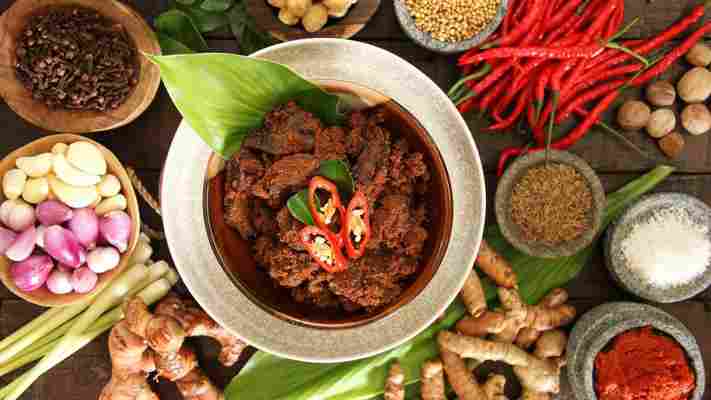Article continues below
The trendy lightbox sign at Singapore’s indie cinema The Projector read ‘Justice for chicken rendang’ in April this year, echoing the hashtags that were blowing up social media at the time. #CrispyRendang and #Rendangate were uniting Malaysians and Indonesians, who were utterly outraged at a diplomatic controversy.
In case you missed the furore , here is what happened: Malaysian contestant Zaleha Kadir Olpin cooked chicken rendang on the British version of MasterChef, which judge Gregg Wallace declared wasn’t ‘crispy’ enough and couldn’t possibly be eaten.

Justice for chicken rendang.jpg
‘Crispy?’ came the rallying cry from South-East Asia. An unctuous, slow-cooked dish of meat with coconut and spices, rendang can be described as many things – rich, spicy, melt-in-the-mouth – but everyone from the former and current Malaysian prime ministers to foreign diplomats and professional Indonesian and Malaysian chefs agree that it is definitely not crispy.
You may also be interested in: • The cuisine only women can master • In Indonesia, the day millions of people go home • Who invented hummus?
It is not often that the neighbouring countries of Malaysia and Indonesia agree. Their relationship has a long history of tension , largely around issues of territorial disputes, colonialism and nationalism. However, when another British MasterChef judge, John Torode, stoked the fire by tweeting that “Maybe rendang is Indonesian!” one social media user, Griffin Seannery in Jakarta, replied , “Trying to make Malaysians and Indonesians fight over the rendang? No, we will unite instead.”
While Torode might have been courting controversy, he was right about one thing. While both Malaysia and Indonesia proudly call rendang their national dish, it does in fact come from Indonesia. And the history of rendang is almost as complex as the rich, multi-layered flavour of the dish itself.
Rendang originated from the Minangkabau people of West Sumatra in Indonesia, who cooked it with water buffalo – an important animal in Minangkabau culture – not chicken or beef for which the dish is probably best known. The meat of the water buffalo is tough, sinewy and perfectly suited to the long cooking time required for rendang. In fact, the word rendang itself comes from merendang , which means slow cooking. Traditionally, the dish is cooked for between three and seven hours over a low heat on a wood fire.
Trying to make Malaysians and Indonesians fight over the rendang? No, we will unite instead
Gusti Anan, professor of history at the University of Andalas in Sumatra, explains how the Minangkabau tradition of merantau (voluntary migration) resulted in the spread of rendang to neighbouring countries in the Malay Peninsula . This tradition of wandering is a version of migration that is unique to the Minangkabau people, which research suggests is connected to its matrilineal tradition where men are considered ‘guests’ in their wives homes and ancestral land is passed to women not men. Men (and also some women) chose to migrate hoping to gain life experience as well as better financial opportunities. They travelled to places like Malaysia and Singapore on foot or by river, and finding food was often a struggle. Anan said, “To solve this problem, they would bring food from their home… and food that could last a long time in good condition is rendang.” Wrapped in plantain or banana leaves, they carried it with them to sustain them on their journey.
The roots of the recipe are not entirely clear. Anan maintains that India had a strong influence in the social, political, economic and cultural life of the Minangkabau people as a result of Indian traders coming to Indonesian islands in the 2nd Century in search of minerals such as gold and tin. Indonesia became a hub for spice trading due to its location between India and China in the 15th Century, and many elements of Indian, Chinese, Arab and European culture were left at places along the trading routes as sailors passed through. This is why it is thought that rendang is a close relation to Indian curry.

Rendang originated from the Minangkabau people of Indonesia’s West Sumatra region (Credit: Melba/Getty Images)
“There is a phase before you get to rendang that we call kalio ,” Anan said, explaining that this stage of cooking the meat in spices and coconut milk before the liquid has evaporated off results in a wetter consistency. He says Minangkabau people call the kalio stage ‘ kari ’, which could be related to the word curry.
Arie Parikesit, a culinary TV host and innovation food campaigner from the Indonesian island of Java, says where he comes from, rendang is eaten kalio-style or ‘half rendang’ and this is the most common version in Malaysia. “But in its authentic state,” he says, “it is rendang hitam (black rendang) – sandy and gritty in a caramelised gravy called dedak rendang .” In Malaysia, there is a similar version – rendang tok – but it is rarer.
Tok – short for datuk – translates as ‘royal’ and is believed to have come from the royal cooks of the Malaysian state of Perak , who added ingredients such as palm sugar and freshly grated coconut that is dry fried, which would have been too expensive for ordinary people.
But even at its origin, rendang was considered an esteemed dish by the Minangkabau people, and one that was the manifestation of their philosophies: patience, wisdom and persistence .
A dish as time-consuming as rendang was (and still is) generally only cooked on special occasions such as weddings or for the coronation of local leaders.

Rendang is a traditional Indonesian and Malaysian slow-cooked dish of meat, coconut and spices (Credit: Ariyani Tedjo/Alamy)
Anan maintains that rendang’s cultural importance cannot be understated. “Rendang means prosperity, wealth and also a kind of creativity of the people,” he said. It is an ‘ adat ’ food – adhering to local customs and traditions of the Minangkabau people.
For brothers Hazmi and Ariff Zin who run Rumah Makan Minang an Indonesian restaurant in Singapore, rendang is the heart of their business. Ariff even wrote a thesis on rendang while at culinary college. He wanted to convert his classmates to the joy of the dish even though (in his own words) “it looks disgusting”.
Hazmi told me that Indonesians prefer it in a more traditional style, where the meat, once softened through the long cooking process, has become almost hardened from being reheated so often. That style of cooking did not appeal to their Singaporean customers, however, and so now, the brothers make it fresh every day. It is served as part of nasi padang , steamed rice accompanied by vast array of dishes such as ikan bakar ( grilled fish in a sweet sauce) and ayam goring (chicken fried with garlic, turmeric and lemongrass).
Rendang is served as part of nasi padang, an array of dishes accompanied by steamed rice (Credit: James Baigrie/Getty Images)
For the Zin brothers, rendang is at the centre of the emotional connection they have to their grandmother’s Minangkabau heritage, who emigrated from there to Singapore in the 1940s. Hajjah Rosemah Binte Mailu first set up a roadside food stall and then a restaurant in the Kampong Glam area of the city, selling food from her hometown. Her daughter Zulbaidah – the Zin brothers’ mother – then opened her own restaurant called Sabar Menanti (Wait Patiently), referring to the queues of people that came to eat the food.
The family takes their rendang very seriously. “Some people come and they ask for curry sauce with it,” Ariff exclaimed. “I tell them if you want curry sauce you can go to McDonald’s.”
I tell them if you want curry sauce you can go to McDonald’s
Despite the Zin brothers being purists about the dish, in contemporary Asia, it is being incorporated into other types of cuisine which some may think is sacrilegious. In Jakarta, Parikesit told me, there is a restaurant that serves rendang lasagne, using rendang in a similar way to ragu. “It’s pretty good,” he laughed.
And there is no doubt the dish has evolved and adapted as it moved around the Nusantara region, a Malay-Indonesian term that refers to the archipelago which includes Indonesia, Malaysia, Singapore and Brunei. Parikesit described how the meat can be replaced by a number of things, such as prawns, jackfruit, samphire and even cockles, to suit an individual’s diet and palate.
Indonesians and Malaysians were up in arms after a MasterChef UK judge claimed a contestant’s rendang should be ‘crispy’ (Credit: WAHYUDI/Getty Images)
Singaporean-Malay Juliah Adnan has been cooking her version of beef rendang for 46 years, having been taught while living in her kampong (village) in Singapore. It is not the same now that everyone lives in flats, she told me. “In a kampong, everyone did everything together – you would go to the same house to cook and eat. Now it’s harder to pass on your heritage.”
She has a particular cooking pot that she always uses to make rendang. “Any other pot would make it taste different,” she explained. “I keep it simple.” To her, good ingredients, good sambal (a spicy chilli sauce), a balance of flavours and patience is key.
Due to the Minangkabau people’s trade relationship with India, it is believed that rendang is a close relation to Indian curry (Credit: yu liang wong/Alamy)
Her recipe differs slightly to the Zin brothers’ one. They use turmeric leaf and both dried and fresh chillies, while Adnan uses candlenuts and only dried chillies (to make sambal). This is one of the beauties of this slow-cooked dish – you can adjust it to suit your own taste.
Dr Shahrim Ab Karim, associate professor of Malaysia’s Heritage Food & Food Culture at University Putra Malaysia, explained that Malaysians, too, have changed the dish over time to call it their own.
Families tend to have their own recipes that they are very proud of – the colour varies from house to house
“Of course we can’t deny it comes from Indonesia, but as time evolved, we made it Malaysian,” he said. “In Malaysia, it is considered a national dish, eaten during prestigious occasions such as weddings or Hari Raya,” referring to the Muslim religious festival that follows a month of fasting during Ramadan.
And while chicken rendang is a more everyday version of the dish, beef rendang is considered more special as it takes much longer to cook and is therefore saved for only the most venerable occasions.
“Families tend to have their own recipes that they are very proud of – the colour varies from house to house,” Karim said. Although recipes tend to be inherited from mothers, Karim learned to cook it from his aunt and has treasured memories of breaking open a fresh coconut and grating it, as well as pressing coconut milk. No shortcuts were taken.
The Minangkabau brought rendang with them to neighbouring Malaysia, where it is now considered a national dish (Credit: Tibor Bognar/Getty Images)
The ingredients might be the same in different recipes but the final dish will taste unique, he explained. The Malay phrase ‘ air tangan’ (meaning ‘water of the hands’) probably best describes the slight variation in home-cooked dishes that is so evocative and comforting; it can only be properly made by whoever cooked it for you growing up.
In Adnan’s house, she is that person, and Hari Raya, for her, means pouring her love and time into feeding her family. That is no mean feat considering it includes her husband, 10 children, soon to be 20 grandchildren and the extended family. Cooking for everyone means catering for at least 40 people. “I cook 15 chickens!” she laughed.
This year, as she gets older, her family is taking over preparing the Hari Raya feast. The huge task will be shared among her relations, each taking on various dishes. She is happy to get the help “but it won’t taste the same,” she said with a glint in her eye.
In Malaysia, rendang is eaten during Hari Raya, the Muslim religious festival – and feast – that follows Ramadan (Credit: David Wingate/Alamy)
Of course, during this year’s Hari Raya, rendang will take on a starring role on the Adnan family’s table. Perhaps it’s Adnan herself who best sums up the unity the dish brings to the region. As a Singaporean-Malay married to an Indonesian, her rendang is a melting pot of the various cultures of her family. And it seems none of the regional variations are crispy.
(Video by Timothy McDonald)
Food Wars is a series from BBC Travel that invites you to feel the heat when passions flare around beloved dishes that shape a culture’s identity.
Join more than three million BBC Travel fans by liking us on Facebook , or follow us on Twitter and Instagram .
If you liked this story, sign up for the weekly bbc.com features newsletter called "If You Only Read 6 Things This Week". A handpicked selection of stories from BBC Future, Earth, Culture, Capital and Travel, delivered to your inbox every Friday.
